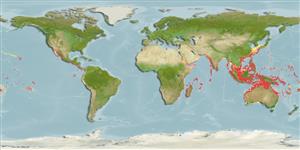Common names from other countries
Environment: milieu / climate zone / depth range / distribution range
экология
ассоциированный с рифами; пределы глубины 0 - 100 m (Ref. 99185). Tropical
Indo-West Pacific.
Length at first maturity / Size / Вес / Возраст
Maturity: Lm ? range ? - ? cm Max length : 17.0 cm TL самец/пол неопределен; (Ref. 92)
One of the most brightly colored stomatopods; with deep blue uropods; those and other appendages lined with bright red setae (Ref 92).
Intertidal to subtidal (Ref. 106854). Lives in existing burrows in shallow and rough bottom habitats, often on or near coral reefs (Ref. 92), and on reef flats at a depth of 36 m (Ref. 80410). Feeds on scyllarids; active during the day; uses its buttressed raptorial claws to smash hard-bodied prey. Largest 'smasher' (Ref. 92).
Life cycle and mating behavior
половая зрелость | размножение | нерест | икра | Fecundity | личинки
Some members of the order Stomatopoda pair for life and some come together only to mate. Males produce sperm ducts rather than spermatophores; females can brood a maximum of 50,000 eggs. Life cycle: Eggs hatch to a planktonic zoea which lasts for 3 months.
Основная ссылка
ссылки | координатор | соавторы
Manning, R.B. 1998. (Ref. 92)
Статус Красного Списка МСОП (Ref. 130435)
Статус СИТЕС (Ref. 108899)
Not Evaluated
Not Evaluated
Угроза для людей
Harmless
Использование человеком
аквариум: коммерческий
| FishSource |
инструменты
дополнительная информация
Возраст/РазмерыростЗависимость между длиной и массой телаЗависимость между длинамиморфологияличинкичисленность
ресурсы в Интернет
Estimates based on models
Preferred temperature
(Ref.
115969): 24.3 - 29, mean 28 (based on 1610 cells).
Уязвимость
Low vulnerability (10 of 100).
Категория цены
Unknown.
